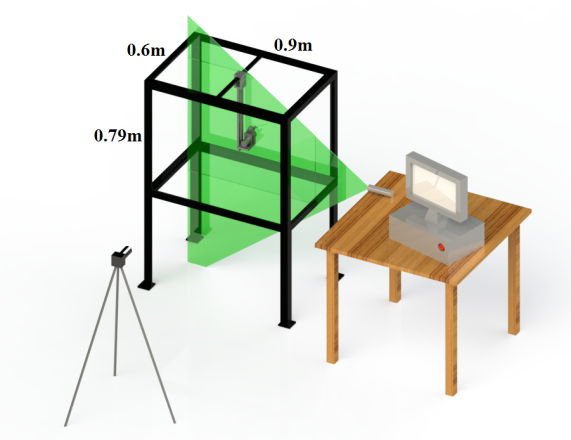Velocity Field around a Rigid Flapping Wing with a Winglet in Quiescent Water
DOI:
https://doi.org/10.46604/aiti.2020.4674Keywords:
square wing, flapping motion, winglet, one-degree-of-freedom flapping, PIV, velocity fieldAbstract
This study investigated the effect of a winglet on the velocity field around a rigid flapping wing. Two-dimensional particle image velocimetry was used to capture the velocity field of asymmetric one-degree-of-freedom flapping motion. A comparison was conducted between wings with and without a winglet at two flapping frequencies, namely 1.5 and 2.0 Hz. The effect of the winglet on the velocity field was determined by systematically comparing the velocity fields for several wing phase angles during the downstroke and upstroke. The presence of a winglet considerably affected the flow field around the wingtip, residual flow, and added mass interaction. The added mass was lower and residual flow was weaker for the wings with a winglet than for the wings without a winglet. The added mass and velocity magnitudes of the flow field increased proportionally with the flapping frequency.
References
R. T. Whitcomb, “A design approach and selected wing-tunnel results at high subsonic speeds for wing-tip mounted winglets,” Washington, United States, Technical Report NASA TN D-8260, July 01, 1976.
S. G. Fletcher and P. F. Jacobs, R. T. Whitcomb, “A high subsonic speed wind-tunnel investigation on a representative second-generation jet transport wing,” Washington, United States, Technical Report NASA TN D-8264. July 01, 1976.
I. Kroo, Drag due to lift: Concepts for prediction and reduction, Annual Review of Fluid Mechanics, 2001.
H. D.Cerón-Muñoz and F. M. Catalano, “Experimental analysis of the aerodynamic characteristics adaptive of multi-winglets,” The Proceedings of the Institution of Mechanical Engineers, Part G: Journal of Aerospace Engineering, vol. 220, no. 3, pp. 209-215, March 2006.
D. P. Coiro, F. Nicolosi, F. Scherillo, and U. Maisto, “Design of multiple winglets to improve turning and soaring characteristics of angelo d’ arrigo’s hang-glider: Numerical and experimental investigation” In: XIX Conggresso Nazionale AIDAA 17-21 September 2007 Aerotecnica Missili e Spazio., vol. 87, no. 2, pp. 74-85, May 2008.
M. Berens, “Potential of multi-winglet systems to improve aircraft performance,” Doctoral Thesis, Technical Univ of Berlin, Germany, 2008.
G. Srikanth and B. Surendra, “Experimental investigation on the effect of multi-winglets,” International Journal of Mechanical and Industrial Engineering, vol. 1, no. 1 pp. 43-46, January 2011.
M. J. Smith, N. Komerath, R. Ames, O. Wong, and J. Pearson, “Performance analysis of a wing with multiple winglets,” In: 19th AIAA Applied Aerodynamics Conference, Anaheim, CA, USA, June 2001, pp. 1-10.
V. A. Tucker, “Gliding birds: Reduction on induced drag by wing tip slots between the primary feathers,” The Journal of Experimental Biology, vol. 180, no. 1, pp. 285-310, July 1993.
K . Kitagawa, M. Sakakinara, and M. Yasuhara. “Visualization of flapping wing of the drone beetle,” Journal of Visualization, vol. 12, no. 4, pp. 393-400, December 2009.
Y. Liu, B. Cheng, and X. Deng. “An application of smoke-wire visualization on a hovering insect wing,” Journal of Visualization, vol. 16, no. 3, pp. 185-187, Auguest 2013.
H. Ren, Y. Wu, and P.G. Huang. “Visualization and characterization of near-wake flow fields of a flapping-wing micro air vehicle using PIV,” Journal of Visualization, vol. 16, no. 1, pp. 75-83, February 2013.
S. Goli, A. Roy, D. K. Patel, and S. Roy, Particle image velocimetry measurements of rigid and flexible rectangular wings undergoing main flapping motion in hovering flight, Fluid Mechanics and Fluid Power-Contemporary Research, 2017.
Y. S. Hong and A. Altman, “Lift from spanwise flow in simple flapping wings,” Journal of Aircraft, vol. 45, no. 4, pp. 1206-1216, July 2008.
H. Hu, A. G. Kumar, G. Abate, and R. Albertani, “An experimental investigation on the aerodynamic performances of flexible membrane wings in flapping flight,” Aerospace Science and Technology, vol. 14, no. 8, pp. 575-586, December 2010.
K. Mazaheri and A. Ebrahimi, “Experimental study on interaction of aerodynamics with flexible wings of flapping vehicles in hovering and cruise flight,” Archieve of Applied Mechanics, vol. 80, no. 11, pp. 1255-1269, November 2010.
S. Goli, A. Roy, and S. Roy, “Vortex filamentation and fragmentation phenomena in flapping motion and effect of aspect ratio and frequency on global strain, rotation and enstrophy,” International Journal of Micro Air Vehicles, vol. 11, pp. 1-30, January 2019.
S. Goli, S. S. Dammati, A. Roy, and S. Roy, “Coherent structures in the flow generated by rigid flapping wing in hovering flight mode,” IOP Conference Series: Materials Science and Engineering, vol. 402, no. 1, pp. 1-18, 2018.
S. Goli, S. S. Dammati, A. Roy, and S. Roy, “Vortex identification and proper orthogonal decomposition of rigid flapping wing,” International Journal of Fluid Mechanics Research (accepted). 2019.

Published
How to Cite
Issue
Section
License
Submission of a manuscript implies: that the work described has not been published before that it is not under consideration for publication elsewhere; that if and when the manuscript is accepted for publication. Authors can retain copyright in their articles with no restrictions. is accepted for publication. Authors can retain copyright of their article with no restrictions.
Since Jan. 01, 2019, AITI will publish new articles with Creative Commons Attribution Non-Commercial License, under The Creative Commons Attribution Non-Commercial 4.0 International (CC BY-NC 4.0) License.
The Creative Commons Attribution Non-Commercial (CC-BY-NC) License permits use, distribution and reproduction in any medium, provided the original work is properly cited and is not used for commercial purposes.







